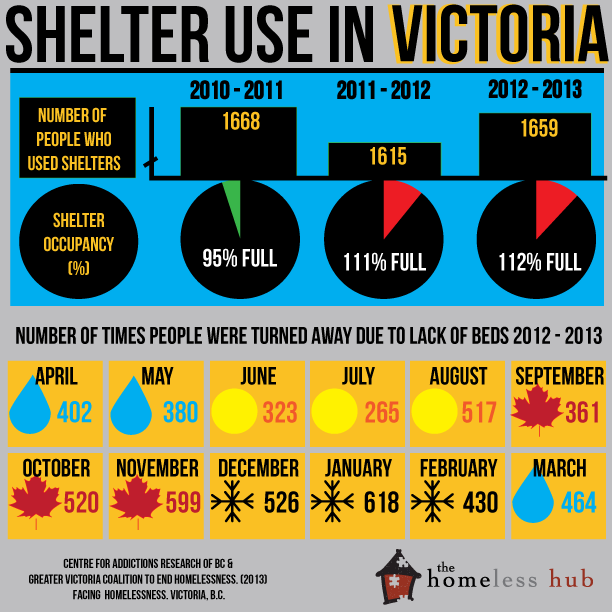This infographic focuses on emergency shelter use. The statistics and information are from the Facing Homelessness report, released by the Greater Victoria Coalition to End Homelessness.
It is alarming that emergency shelters are operating at above their capacity. I chose to use the images to represent the months of the year, to highlight the importance of seasonal experiences on homelessness. For those who have stable housing, or support networks, rain, wind, snow and sun can be inconveniences. However, for those with inadequate housing, they can represent real dangers.
While our long-term goals should be ending homelessness as a social category, it is important that people have places to go in emergencies. I’ve had this explained to me using the analogy of healthcare. Though Emergency Rooms tend to be expensive and a preference for addressing healthcare may be homecare, family doctors, healthcare teams or preventative care, it is hard to imagine closing down all of the emergency rooms. There will always be emergencies, no matter how good the other levels of care are. With homelessness, there will likely always be a need for emergency shelters. Problems emerge when there is a lack of other services that allow people to leave the shelter after a short time. Without adequate support, the emergency doesn’t end.
In the context of Victoria, the Victoria Cool Aid Society is a good example of an organization that has a range of services available for those experiencing homelessness. These services include: three shelters, a transitional shelter and an extreme weather shelter. Some of the other services include food security, education, employment, health, dental and mental health supports.
Despite several good organizations that are working to end homelessness in Victoria, shelters are still operating at over their capacity, forcing shelters to lay out mats in common areas to provide additional beds during the winter.
The Facing Homelessness report uses a ‘3pm turnaway’ statistic to report the number of people who were turned away due to the lack of available beds. This means that there was no bed available for an individual in the morning, and when they returned at 3pm the same day, there was still no bed available. Sometimes this can continue for multiple days in a row.
The Homeless Hub's latest e-book on Housing First in Canada, uses Victoria as a case study to show how a program from a large city can be adapted and replicated in a smaller community. A new report just released today, entitled What Works and For Whom?, provides 8 case studies highlighting initiatives and programs that are run throughout Canada (one of those case studies is the Victoria Cool Aid Society).


